Overview
The article addresses a significant challenge faced by many tech startup founders: mastering App Store Optimization (ASO) to improve the visibility and downloads of their mobile applications. It's not just about getting noticed; it's about standing out in a crowded marketplace where every download counts. The implications of poor visibility can be daunting, leading to frustration and lost opportunities. However, there is hope. By focusing on essential steps like:
- Optimizing app titles and keywords
- Enhancing visual assets
- Encouraging positive user reviews
- Continuously monitoring and adjusting ASO strategies
founders can foster sustained growth and engagement. These practices are not merely strategies; they are vital lifelines in a competitive app market. Remember, you are not alone in this journey, and with the right approach, success is within reach.
Introduction
In today’s digital landscape, where over six million mobile applications compete for attention, the struggle for visibility can feel overwhelming. Many developers and marketers find themselves grappling with the challenge of making their app stand out. This quest for discoverability is not just about numbers; it’s about reaching users who genuinely need what you offer. The pain of being overlooked in such a crowded space is real, and it can be disheartening.
But there is hope. App Store Optimization (ASO) emerges as a nurturing solution, a powerful tool that can enhance your app’s visibility, drive organic downloads, and foster meaningful user engagement.
So, how can you effectively navigate the complexities of ASO and ensure your app shines in this competitive arena? This article will guide you through essential steps for mastering app store optimization, providing insights that can transform your app’s presence and success in the market.
Together, we can embark on this journey to elevate your app and connect with the users who will benefit from it the most.
Define App Store Optimization (ASO)
App Store Optimization is a vital process for enhancing the visibility of mobile apps in platforms like Google Play and Apple's App Store. With over 6 million apps available, the challenge of standing out can feel daunting. The primary aim of app store optimization (ASO) is to increase organic downloads by optimizing various elements of an app's listing, including its title, keywords, description, and visual assets. By implementing effective app store optimization strategies, developers can improve their app's discoverability, attract more users, and ultimately drive higher engagement and revenue.
ASO is often likened to Search Engine Optimization (SEO) for websites, as both seek to improve visibility and attract traffic. Yet, (ASO) specifically focuses on app stores and the unique algorithms that dictate app rankings within these platforms. For any app developer or marketer striving for success in the competitive mobile app market, understanding app store optimization is essential.
The benefits of implementing app store optimization strategies are significant. Effective app store optimization can lead to higher app rankings, which correlate with increased visibility and download rates. As we look toward 2025, the app market will continue to evolve, and the importance of app store optimization will only grow—especially as brand-name searches become more prominent than generic ones. Industry leaders remind us that app store optimization is not merely a one-time task; it is an ongoing journey that demands continuous monitoring and adaptation to shifting trends. As Kevin Gibbons, Founder of Re:signal, wisely notes, "ASO is nothing that can be done in five minutes. It is a process that needs to be monitored continuously and requires both time and effort."
Real-world examples highlight the effectiveness of app store optimization (ASO). For instance, a sleep app successfully increased its monthly traffic from 6,500 to 20,000 visitors through targeted ASO efforts, demonstrating the tangible impact of optimized app listings. Additionally, app evaluations and scores play a crucial role in enhancing visibility in app stores, underscoring the necessity for developers to actively engage with their audience. As the mobile app ecosystem continues to expand, mastering app store optimization will be essential for developers aiming to enhance their app's visibility and drive sustainable growth. Together, we can navigate these challenges and create a brighter future for your app.
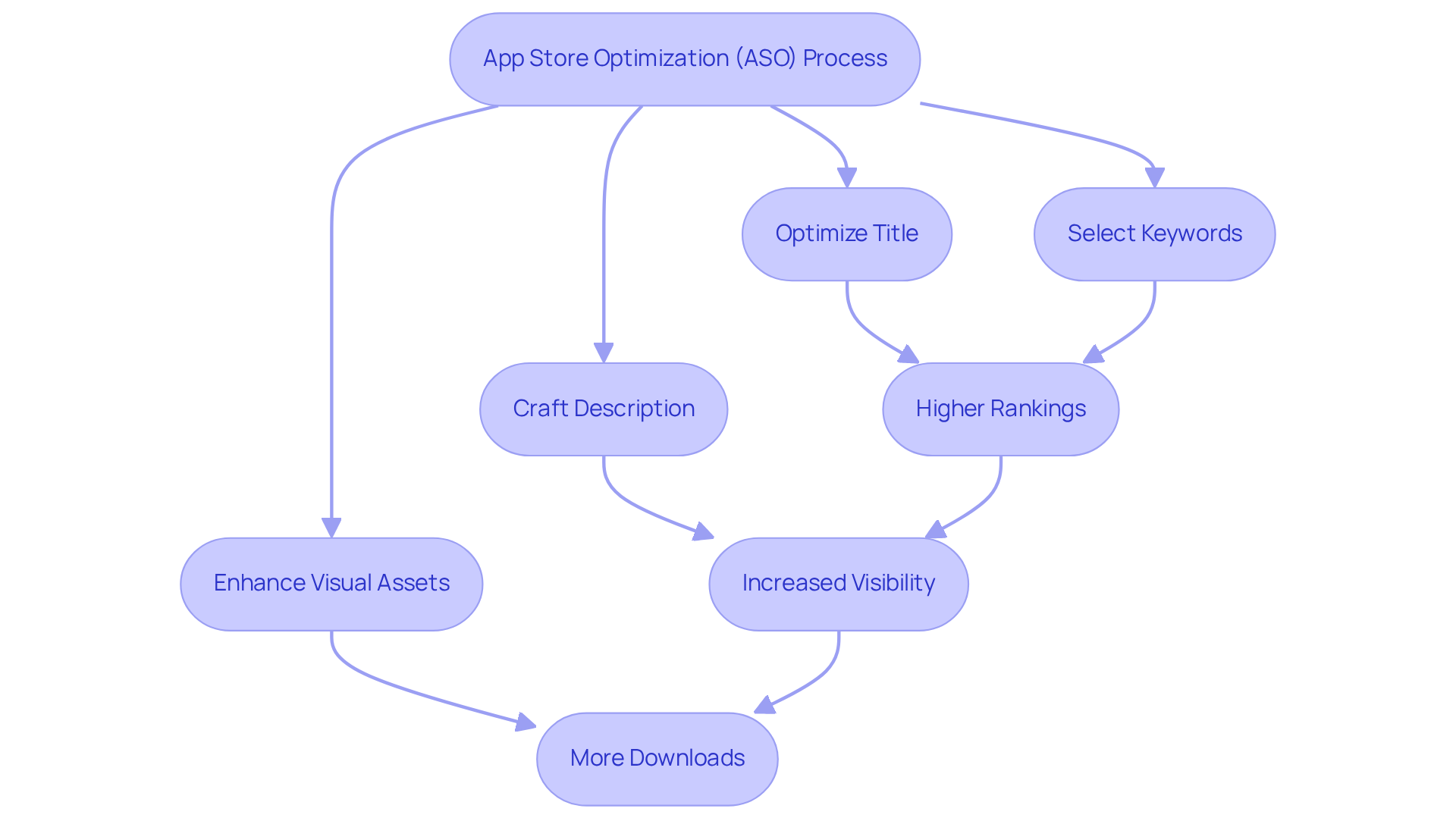
Identify Key Elements of ASO
Navigating the world of app store optimization can often feel overwhelming. Many app developers struggle to make their apps stand out in a crowded marketplace, which can lead to frustration and uncertainty. But there are key elements that can help you enhance your app's visibility and connect with your audience more effectively.
App Title: Think of your app title as your first handshake with potential users. It’s vital to make it catchy and relevant, incorporating main terms that boost your search visibility. Did you know that titles with effective keyword integration can rank in the top five positions of Google 85% of the time? This simple yet powerful strategy can make a significant difference.
Choosing the right terms is essential for increasing your app's visibility. By conducting thorough keyword research, you can pinpoint the terms that potential visitors are actively searching for. Consider using long-tail phrases; they not only offer precision but also reduce competition, making it easier for your app to engage with its audience.
App Description: Your app description should be a warm invitation, clearly articulating your app's purpose, features, and benefits while seamlessly . With up to 4,000 characters available in the App Store, you have ample space to engage individuals and improve your search rankings.
Visual Assets: High-quality visuals, such as app icons, screenshots, and promotional videos, play a crucial role in attracting your audience. Effective screenshot design can lead to improved conversion rates, as 90% of the information processed by the brain is visual. Remember, the brain processes images 60,000 times faster than text! Ensure your visuals showcase your app's functionality and appeal, creating a lasting impression.
User Ratings and Reviews: Positive ratings and reviews not only enhance your app's credibility but also influence its rankings. Apps boasting an average rating of 4.0 stars or higher often see a positive impact on conversion rates, while those with three stars may face challenges. Encouraging users to provide feedback is essential for ASO success, as customer reviews significantly impact app downloads. Additionally, utilizing in-app notifications can boost retention by 30%, further enhancing engagement.
Category Selection: Selecting the right category for your app is critical for reaching the right audience and improving its chances of being featured in app store rankings. Proper categorization can enhance visibility and attract users actively seeking functionalities related to your app's niche. Remember, continuous app store optimization practices are essential for maintaining your app's visibility and competitiveness in the market.
By focusing on these key elements, you can navigate the complexities of app store optimization with confidence and connect more deeply with your audience. We understand the challenges you face, and we’re here to support you every step of the way.
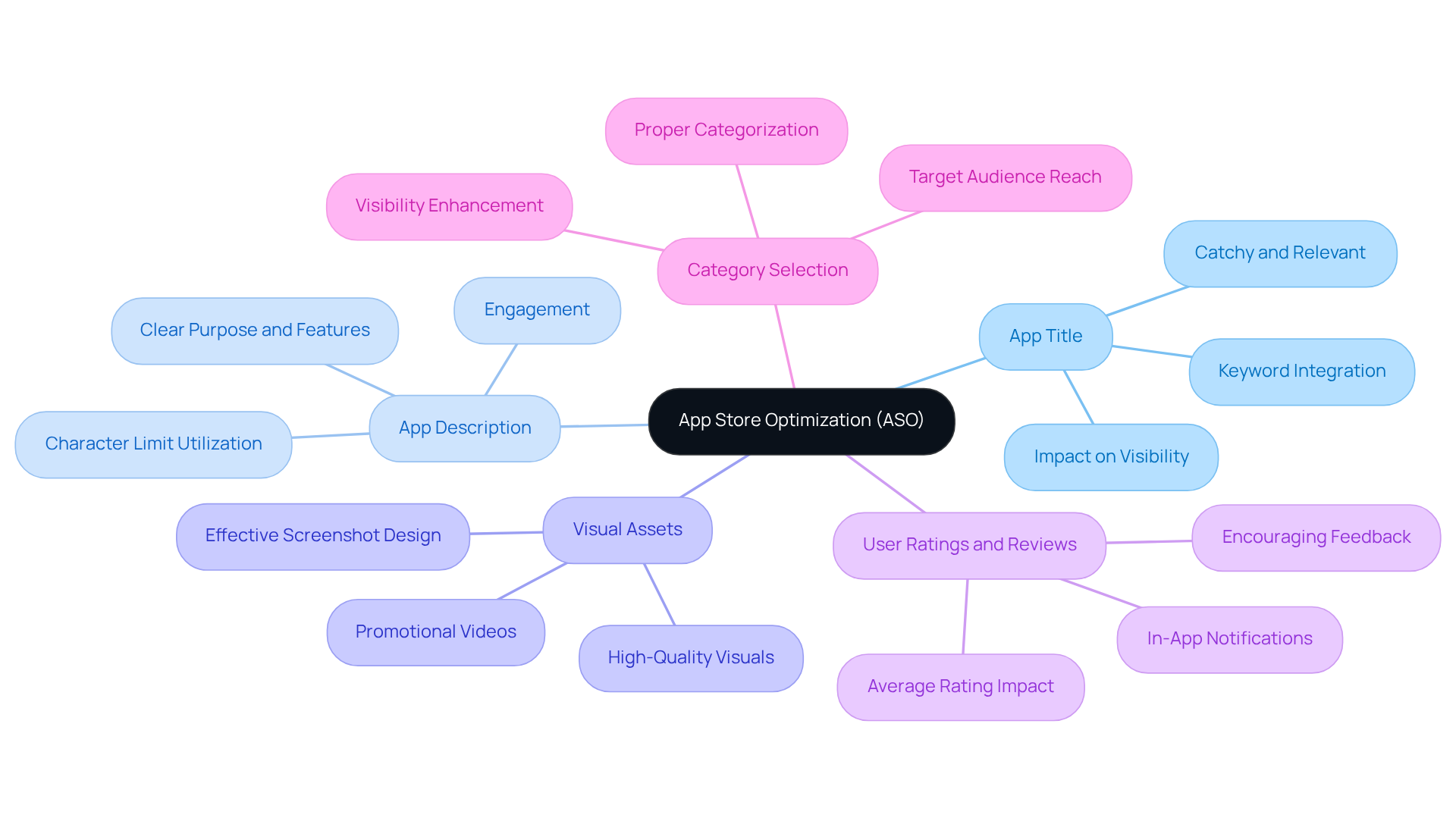
Optimize App Titles and Keywords
To effectively implement app store optimization for your app title and keywords, it’s essential to recognize the challenges you face in standing out in a crowded marketplace. Many startup founders struggle with achieving visibility, which can be disheartening. But don’t worry; by following these steps, you can significantly improve your app's discoverability and download potential.
- Conduct Keyword Research: Start by leveraging tools like AppTweak or Sensor Tower to uncover high-traffic terms that resonate with your app's purpose. It’s important to aim for terms that balance search volume and competition, ensuring they are relevant to your target audience. Remember, 65% of all app downloads come directly from searches on the App Store, emphasizing the critical nature of app store optimization.
- Incorporate Keywords in the Title: Integrate your primary keyword into the app title while keeping it concise and engaging. For example, if your app serves as a fitness tracker, consider a title like "FitTrack: Your Personal Fitness Companion." This approach effectively communicates the app's purpose while inviting users to connect with it.
- Utilize the : For iOS applications, make the most of the keyword section by adding relevant terms that may not fit in the title. Focus on specific terms that accurately reflect your app's functionality to enhance discoverability. Avoid using special characters unless they are essential to your branding, as clarity is key.
- Monitor Competitors: Keeping an eye on rivals' app titles and terms can help you identify market trends and potential gaps. This analysis may reveal effective strategies that you can adapt, allowing you to differentiate your app in a competitive landscape. Understanding what works for competitors can provide valuable insights into your own approach.
- Test and Iterate: Regularly experiment with different title variations and keyword combinations to discover which configurations yield the best results. Employ A/B testing to refine your approach based on performance metrics, ensuring continuous improvement in your app's visibility. For instance, the success of MUCUDU in attracting early adopters showcases the positive impact of effective ASO practices.
By following these steps and incorporating best practices for app store optimization, you can create a supportive environment for your app's growth and significantly enhance its visibility. Remember, you’re not alone in this journey; many have faced similar challenges and have found success through perseverance and strategic action.
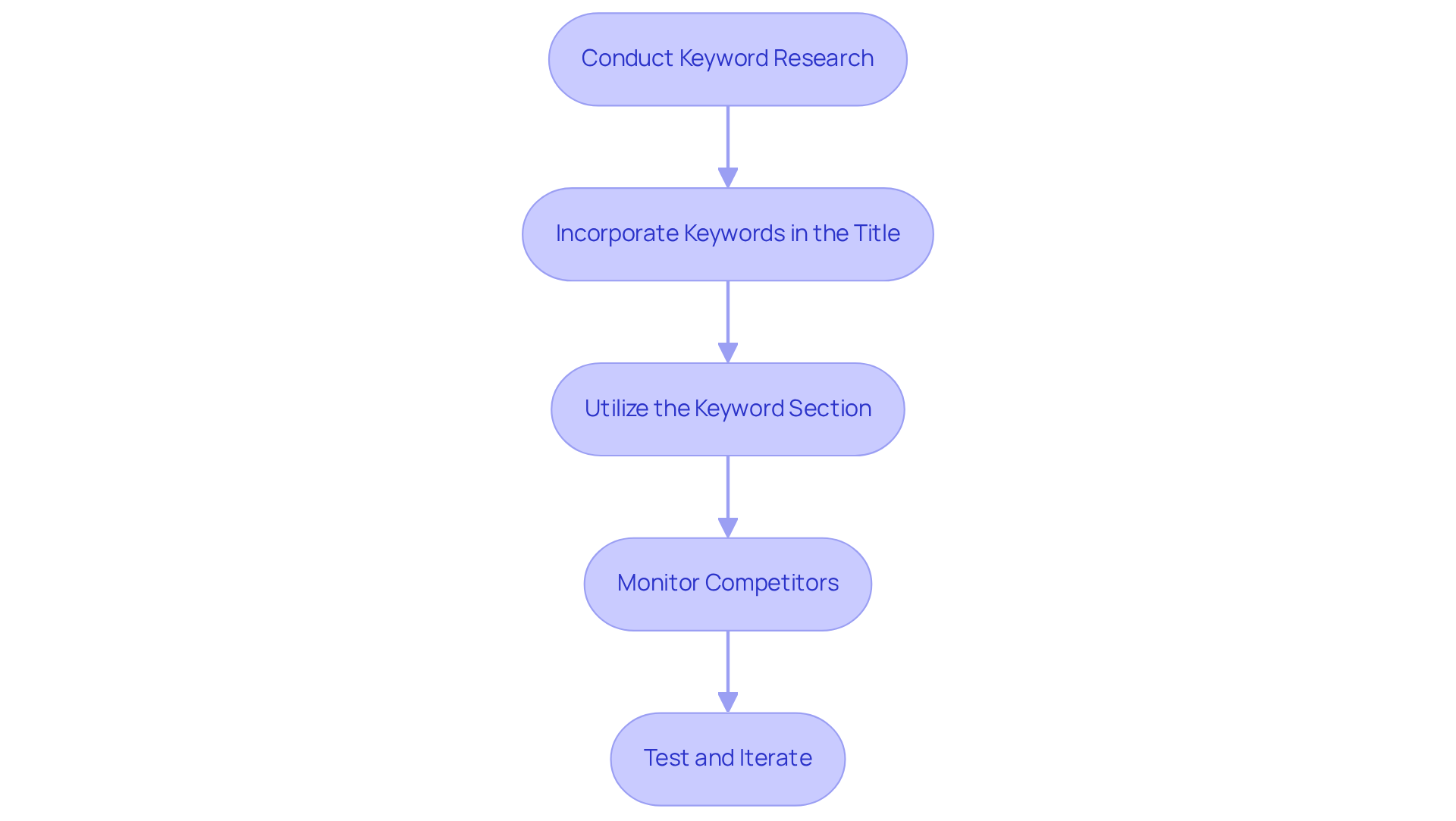
Enhance Visual Elements for Engagement
To enhance visual elements for better engagement, it's essential to recognize the challenges many tech startup founders face in a crowded marketplace. The pressure to stand out can be overwhelming, and the fear of being overlooked is real. But there are ways to alleviate this concern and create a lasting impression.
- Create an Eye-Catching App Icon: Your app icon is often the first impression potential users will have. It’s crucial to design an icon that is visually appealing, simple, and representative of your app's purpose. A well-crafted icon can truly stand out through app store optimization, capturing attention amidst the noise. At RNO1, we believe that a thoughtfully designed icon can significantly elevate your brand's marketability, aligning perfectly with our Return On Design & Digital (RODD) strategies.
- Utilize High-Quality Screenshots: High-resolution screenshots play a vital role in showcasing your app's key features and user interface. They should emphasize functionality and the overall experience to attract potential users. We understand the significance of captivating visuals at RNO1, which is why we emphasize of our RODD strategies.
- Include a Promotional Video: A brief promotional video can effectively highlight your app's features and engage viewers. Focusing on your app's unique selling points while keeping the video concise can help maintain interest. At RNO1, we prioritize design-driven solutions that enhance engagement through impactful storytelling, a principle deeply embedded in our RODD strategies.
- A/B Test Visuals: It’s essential to experiment with various visual assets to see which resonate best with your audience. A/B testing allows you to compare performance metrics and make informed, data-driven decisions. Our RODD strategies can guide you in optimizing these visuals for maximum impact, particularly through app store optimization, highlighting the importance of effective design.
- Optimize for Different Devices: Tailoring your visuals for various screen sizes and resolutions ensures a consistent experience across devices. This approach not only improves user satisfaction but also boosts engagement. By implementing these strategies, you can significantly enhance engagement and retention, reinforcing RNO1's commitment to design-focused solutions. Remember, you're not alone in this journey; we're here to support you every step of the way.
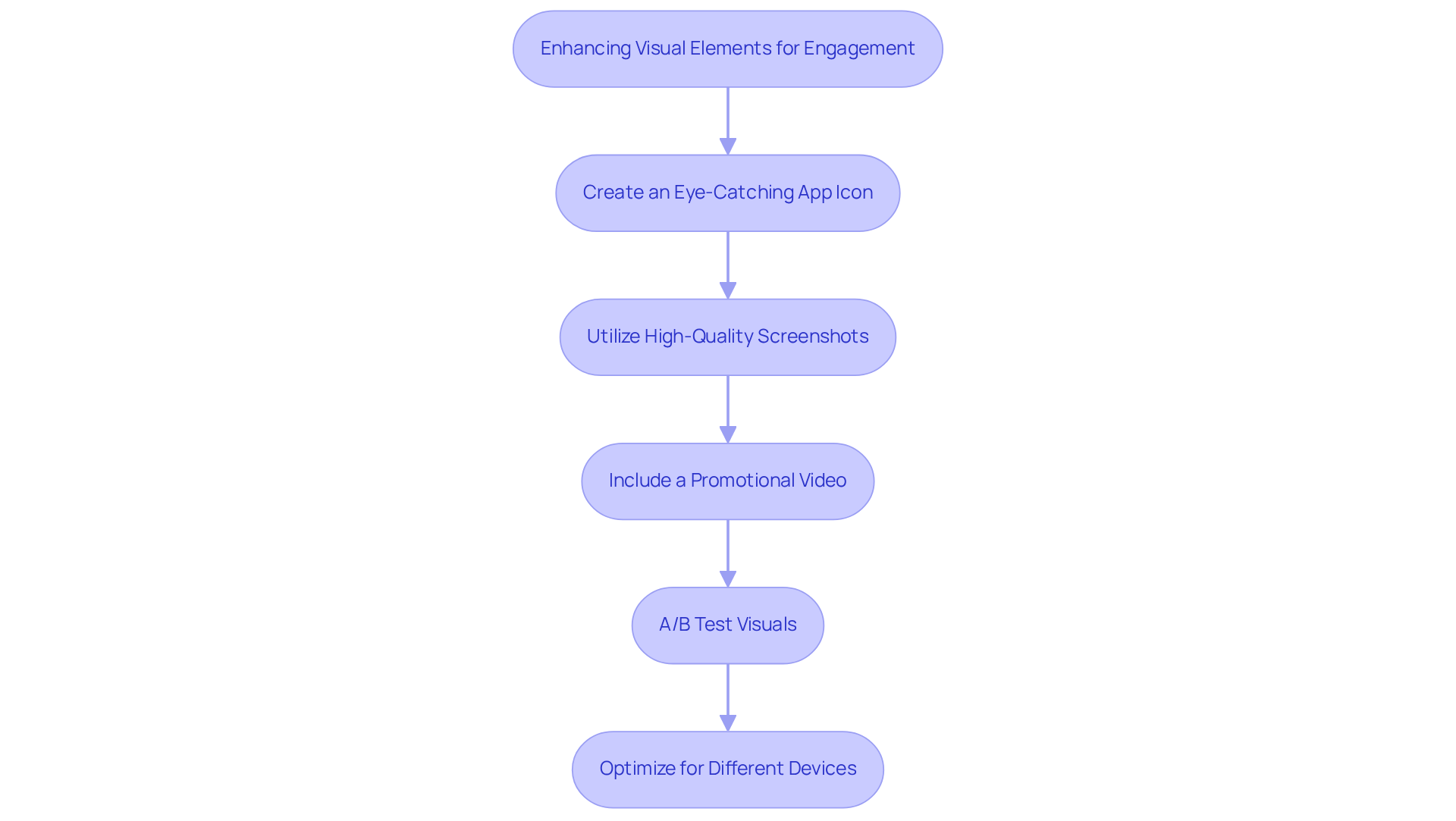
Encourage Positive User Reviews and Ratings
To foster positive user reviews and ratings, it’s essential to address a common challenge many app developers face: how to encourage users to share their experiences. This can often feel daunting, but with the right strategies, you can create an environment where feedback flourishes.
- Request Feedback at the Appropriate Moment: Imagine a user who has just completed a task or reached a milestone within your app. This is the perfect moment to encourage them to leave a review. Timing is crucial; studies indicate that people are more likely to respond positively when approached shortly after a rewarding interaction. By recognizing their achievement, you not only prompt them to share their thoughts but also enhance their overall experience.
- Simplify the Review Process: Consider how frustrating it can be to leave feedback when the process is cumbersome. To alleviate this, streamline the method for users to offer feedback by incorporating direct links to the app store review page, which is essential for app store optimization, within your application. A seamless experience motivates more individuals to share their thoughts, enhancing your app's visibility and reputation.
- Engage with Individuals: When users take the time to provide feedback—whether positive or negative—responding to them shows that you genuinely . This interaction fosters a sense of community and demonstrates your commitment to improving their experience. As Jeff Bezos wisely noted, "Your brand is what other people say about you when you're not in the room." This highlights the importance of managing your brand's reputation through meaningful audience engagement.
- Encourage Feedback: Think about the power of incentives. Offering in-app rewards or discounts for users who submit a review can be a great motivator. Just ensure these incentives comply with app store optimization guidelines to maintain integrity while encouraging participation. It’s a win-win situation that can lead to valuable insights.
- Monitor and Analyze Feedback: Regularly reviewing client feedback is vital for identifying common themes and areas for improvement. By utilizing this information, you not only enhance your app but also address customer concerns, creating a community of loyal patrons. Companies that prioritize listening to customer feedback can significantly improve their offerings and client satisfaction. Remember, for every one-star review, you need seven five-star reviews to average a 4.5-star rating. This statistic underscores the critical nature of positive feedback and the importance of nurturing user relationships.
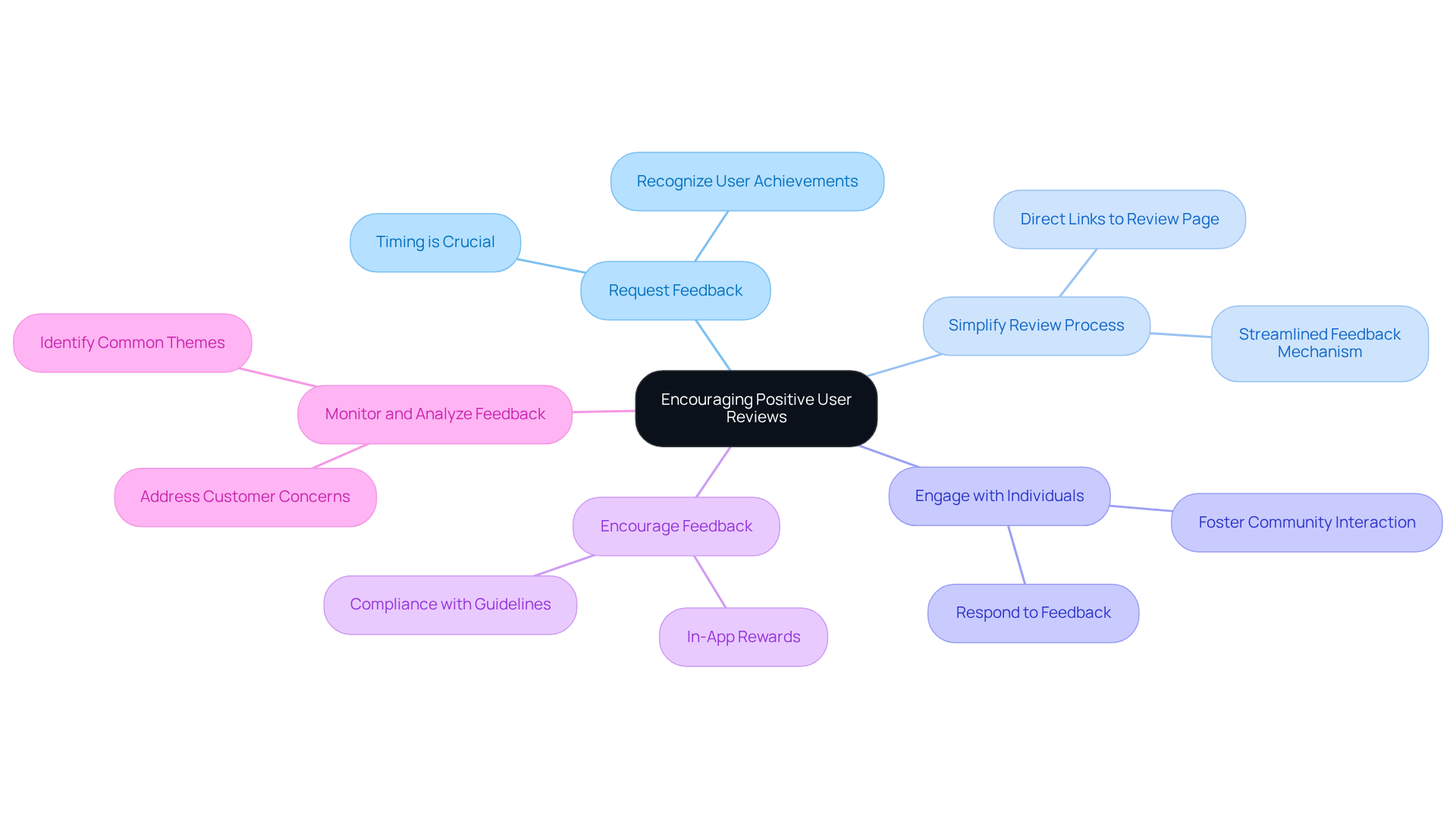
Monitor and Adjust ASO Strategies
To effectively monitor and adjust your ASO strategies, it's important to recognize the challenges you face. Many app developers struggle to understand how to improve their visibility and downloads in a competitive market. Let’s explore some nurturing steps you can take to enhance your ASO efforts.
- Track Key Performance Indicators (KPIs): Focus on metrics such as app downloads, engagement levels, and conversion rates. These indicators are essential for assessing the effectiveness of your ASO efforts and understanding user behavior. It’s significant to note that 80% of individuals examine ratings and reviews prior to downloading an app. This feedback is crucial for your growth and improvement.
- Use : Consider leveraging advanced tools like AppTweak and MobileAction to track keyword rankings, app visibility, and competitor performance. For instance, video content is included in 60% of games and 74% of educational applications on average. This highlights the importance of visual components in captivating audiences and enhancing conversion rates, ultimately supporting your app's success.
- Regularly Update Metadata: Keeping your app's title, description, and keywords current based on performance data and market trends is vital. Frequent updates not only help preserve or boost rankings but also signal to users that your app is actively supported. Remember, an average individual does not linger on an app's page for over 2 seconds, so concise and compelling descriptions are essential.
- Analyze Feedback: Continuously reviewing ratings and evaluations can reveal areas for enhancement. Engaging with user feedback enables you to make informed adjustments to your app and ASO strategies, ultimately leading to better user satisfaction and retention. For example, Wargaming’s World of Warships Blitz achieved a more than 35% increase in app impressions through effective ASO strategies tailored for different locales. Your willingness to listen and adapt can make a significant difference.
- Stay Informed on ASO Trends: It's important to keep abreast of the latest ASO trends and algorithm changes in app stores. Adapting to these changes can provide your app with a competitive edge, enhancing its visibility and attracting more downloads. Additionally, consider incorporating long-tail keywords, which often have lower competition and can be easier to rank for. By staying informed, you empower yourself to make the best choices for your app's future.
![]()
Conclusion
Mastering App Store Optimization (ASO) is a vital journey for any mobile app developer striving to succeed in a competitive landscape. Many developers face the challenge of making their app visible amidst countless options. This struggle can often feel overwhelming. However, by enhancing an app's visibility through thoughtful optimization of its title, keywords, description, and visual elements, developers can significantly increase organic downloads and user engagement. Remember, ASO is not a one-time task; it requires ongoing attention and adaptation to market trends to ensure lasting success.
This article outlines essential steps for successful ASO, starting with defining key elements such as app titles, descriptions, and user ratings. It highlights the importance of conducting thorough keyword research, crafting compelling visual assets, and actively engaging with user feedback. Real-world examples illustrate how targeted ASO efforts can lead to remarkable increases in app visibility and downloads, reinforcing the idea that a well-optimized app has a better chance of thriving in the crowded app marketplace.
In conclusion, the importance of App Store Optimization cannot be overstated. As the app market continues to evolve, embracing best practices in ASO will be crucial for developers looking to enhance their app's discoverability and drive growth. By prioritizing ASO strategies and staying informed about industry trends, developers can navigate the complexities of the app ecosystem and position their apps for long-term success. Taking proactive steps today can pave the way for a brighter future for your app, ensuring it stands out in the sea of millions.
Frequently Asked Questions
What is App Store Optimization (ASO)?
App Store Optimization (ASO) is a process aimed at enhancing the visibility of mobile apps in app stores like Google Play and Apple's App Store. It involves optimizing various elements of an app's listing, such as its title, keywords, description, and visual assets, to increase organic downloads and improve discoverability.
How does ASO compare to Search Engine Optimization (SEO)?
ASO is similar to SEO in that both aim to improve visibility and attract traffic. However, ASO specifically focuses on app stores and the unique algorithms that determine app rankings within these platforms.
Why is ASO important for app developers?
ASO is crucial for app developers because it can lead to higher app rankings, increased visibility, and greater download rates. As the app market evolves, effective ASO strategies will become increasingly important for success.
What are the key elements of ASO?
The key elements of ASO include:
- App Title: It should be catchy and relevant, incorporating main terms for better search visibility.
- Keyword Research: Identifying effective keywords, including long-tail phrases, to improve visibility.
- App Description: Clearly articulating the app's purpose and features while incorporating relevant keywords.
- Visual Assets: Using high-quality visuals like icons and screenshots to attract users.
- User Ratings and Reviews: Encouraging positive feedback to enhance credibility and influence rankings.
- Category Selection: Choosing the right category to reach the target audience and improve chances of being featured.
How can the app title impact ASO?
A well-crafted app title can significantly boost search visibility. Titles that effectively integrate keywords can rank in the top five positions of Google 85% of the time, making it a powerful strategy for attracting potential users.
What role do user ratings and reviews play in ASO?
Positive ratings and reviews enhance an app's credibility and influence its rankings. Apps with an average rating of 4.0 stars or higher often see improved conversion rates, while those with lower ratings may struggle. Encouraging user feedback is essential for ASO success.
Why are visual assets important for ASO?
High-quality visual assets, such as app icons, screenshots, and promotional videos, are crucial for attracting users. Effective visuals can lead to improved conversion rates, as the brain processes images significantly faster than text.
Is ASO a one-time task or an ongoing process?
ASO is not a one-time task; it is an ongoing journey that requires continuous monitoring and adaptation to shifting trends in the app market. Regular updates and optimizations are essential for maintaining visibility and competitiveness.




